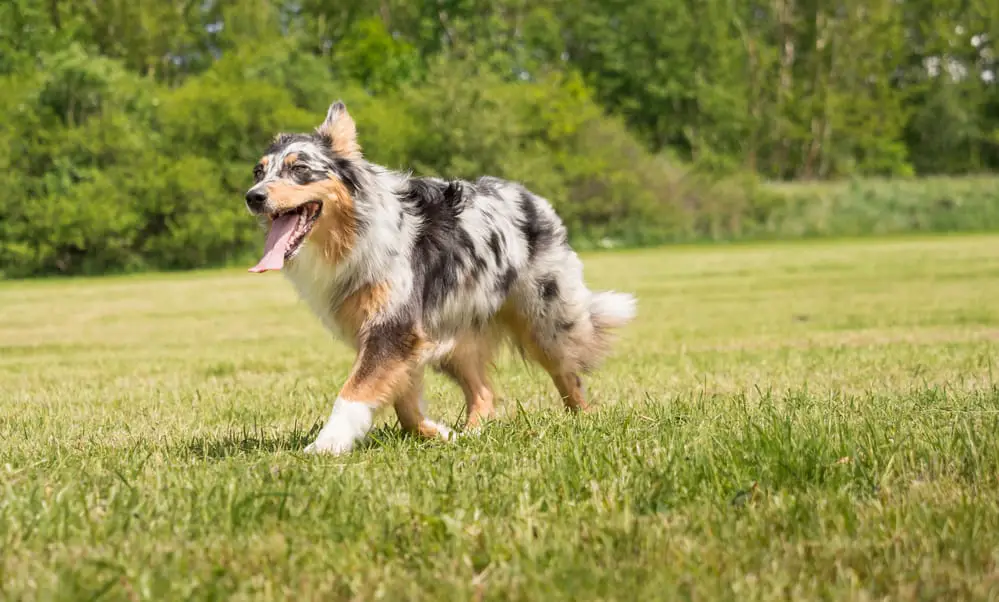The Blue Merle Australian Shepherd is one of the unique looking breeds of dog out there – and its unique look is what attracts so many people to it.
Though I’ve never owned this breed of dog, I’ve always been drawn to them and their unique beauty.
But is the personality of the Blue Merle as beautiful as their coat? Do they make good family dogs?
And what other things should you know if you are looking at bringing a Blue Merle into your home?
Today we will answer all of these questions and more.
First off, let me start by saying that yes, the personality of the Blue Merle matches that of their coat – beautiful.
While every dog has their unique personality, most Blue Merles, when properly trained and socialized, grow up to be very well adapted dogs that make excellent family pets.
With that said, the breed isn’t for everyone.
To help you determine if it’s the right breed for you, today we will focus on questions like:
- What exactly is a Blue Merle?
- What is the temperament of Blue Merle Australian Shepherd?
- Do all Blue Merles have blue eyes?
-And many more. So let’s not waste any more time!
What Is A Blue Merle Australian Shepherd?

Despite what the name suggests, the Australian Shepherd didn’t actually originate in Australia – it originated in the U.S.[1]
The breed first came to be known in the 1840s when they were used for herding livestock.
And while the breed is still happiest when given a job to do, they also make excellent family pets – and their main attraction is their unique appearance.
There are actually several different breeds of Australian Shepherd out there, and the term “Blue Merle” is used to describe a subset of the breed with specific coat color.
This subset of the Australian Shepherd is best known for its combination of blue, black, grey, and white fur.
Other coat colors of the Aussie Shepherd include red merle, red or black tricolor, black, and red.
The standard size of the breed is between 18-23 inches tall, and between 40-65 pounds, making them a mid-size breed when compared to others.
The breed has short, floppy ears, and a long tail, though this tail can also be docked.
The breed has a long, double coat of fur that sheds year-round, but more heavily in the spring.

Because they have such a thick, dense coat of fur, the breed requires a lot of grooming.
Weekly brushing and regular visits to the groomer are a necessity for this breed.
Australian Shepherds are known to be a relatively healthy breed of dog, but there are some known health issues common to the breed.
These may include but are not limited to, hip dysplasia, elbow dysplasia, eye disease[2], drug sensitivity, and epilepsy.
To ensure that you are getting the healthiest pet possible, it’s always important that you buy from a reputable and trustworthy breeder.
Blue Merle Australian Shepherd Temperament

The Australian Shepherd was developed to be a moderate sized, intelligent, all-purpose stock dog of great character and endurance.
-The Australian Shepherd Club Of America
Because of their background, the breed has a strong herding instinct and may become protective when strangers are nearby their family or territory.
This protective instinct is unlikely to turn aggressive unless the dog is strongly provoked.
In terms of family life, Australian Shepherds make excellent pets and do well with both children and other dogs.
With that being said, the breed does have a herding instinct and may, therefore, chase after anything smaller in size like cats or rabbits.
Like with all breeds, behavior like this can be tamed with early socialization and training.
This breed of dog has a great deal of energy, but can also be very easy going when they get the proper amount of exercise.
Because they have been long bred as working dogs, they tend to be very active, and need to stay busy throughout the day.

This breed requires a great deal of playtime, physical activity, and mental stimulation.
If left alone for long periods, the Australian Shepherd can become depressed, anxious, or even destructive. They are best suited to country living, or for owners with a large yard.
Like most herding dogs, the Blue Merle Australian Shepherd is extremely loyal to family members but may be slightly standoffish with strangers.
When not provided with strong and confident leadership, the Blue Merle may try to take on the dominant role within the home. For this reason, they aren’t well suited to first-time pet owners, or timid pet owners.
Most Aussie pet owners will tell you that Australian Shepherds are a very emotional breed with a lot of feelings.
They crave attention, interaction, and activity, and when not given what they need, they will pout or “whine” to you. In other words, their personality is as unique as their coloring.
Do All Blue Merle Aussies Have Blue Eyes?

One of the most recognizable traits of the Blue Merle Australian Shepherd is the baby blue eyes.
But while many of the Blue Aussies do have baby blue eyes, this isn’t the case for all of them. Other common eye colors for the Blue Aussie include brown, hazel, amber, and green.
It’s also not uncommon for the Blue Merle to have a condition called heterochromia, or two different colored eyes.
In such a case, the eyes may be any combination of brown, hazel, blue, amber, and green.
In some cases of Heterochromia, the dog may also have several different colors within one eye, or the eye may take on a haloed appearance.
This condition is caused by an excess or lack of melanin in one eye and can occur at birth or develop over time. Genetics and injury may both play a role in the development of Heterochromia.
Despite the wide held belief that this condition is related to blindness, it actually has no adverse effects on vision.
The Miraculous True Story Of The Blue Merle Australian Shepherd Who Lived

Imagine that you were walking up the final ascent of a gorgeous 13,041-foot summit with your best friend Merle[3] in town, when all of a sudden, you hear a familiar yelp.
Not thinking anything of it, you continue with your journey until you suddenly realize that your best friend is no longer beside you.
That yelp – it wasn’t one of pleasure as it had been for the beginning of the journey. Instead, it was a yelp for help.
As you continue to call your best friend’s name, you suddenly see his paw prints in the snow – but they don’t lead anywhere good.
They lead to the edge of a cliff with an 800-foot drop. Your heart suddenly ends up in your throat, and you realize now exactly what that last yelp meant.

This is exactly what happened to one runner when hiking up the Grand Traverse Peak in Colorado -except thankfully, the story didn’t have the tragic ending that we might all expect.
Rather than looking down and seeing his dog lying on the rocks, he saw movement! Merle Hamburger (his dog’s name) was sprinting away from him down the ridge. So naturally, he did what any pet owner would do, and found a safe way to climb down to him.
But after a long journey of chasing after Merle, he was found inside of a cave (for which he climbed to find shelter) and took his last breath – or so the owner thought.
That was until three weeks later, when a local real estate agent found a raggedy dog walking by the deck.
Seeing that the dog was clearly in distress, the lady quickly swept him up and took him to the Animal hospital. Miraculously, it was Merle.
Though he had two detached retinas, a punctured lung, lacerations on his face, sores on his legs, and lost a third of his body weight, Merle had somehow come back from the dead and made his way home.
According to the vet, it was probably his high level of intelligence combined with the strong herding instinct that helped him survive and find his way home.
Merle reunited with his family photo

Merle had the will to live, the motivation to make a treacherous journey to find his owners, and is an inspiring story of exactly how bonded the Blue Merle Australian Shepherd can be to its family. (image source)
Conclusion:
The Blue Merle Australian Shepherd is a breed that develops a strong bond with its family members and makes an excellent companion for all ages.
Having said that, it is an active breed and does require a great deal of attention, exercise, and mental stimulation.
If you don’t have the time or space for this breed, you may want to consider other options.
But that’s another story…
You can find more United States Dog Breeds in the links below:
References:
1. [^] “Australian Shepherd.” Wikipedia, Wikimedia Foundation. https://en.wikipedia.org/wiki/Australian_Shepherd.
2. [^] Munyard, Kylie A, et al. “A Retrospective Evaluation of Congenital Ocular Defects in Australian Shepherd Dogs in Australia.” Veterinary Ophthalmology, U.S. National Library of Medicine, 2007, https://www.ncbi.nlm.nih.gov/pubmed/17204124.
3. [^] Strokes, Tess, and Eric Wagenknecht. “The Miraculous True Story of the Dog Who Came Back from the Dead.” Outside Online, 15 July 2019, https://www.outsideonline.com/2323581/dog-who-came-back-dead.

